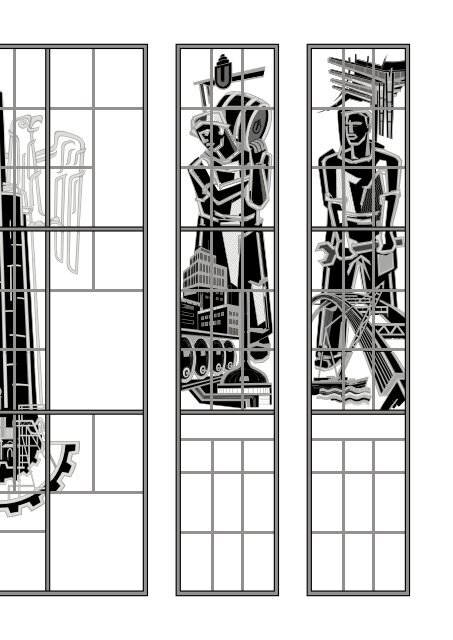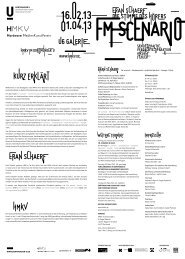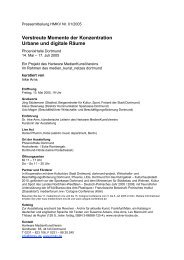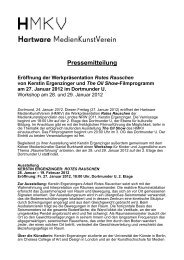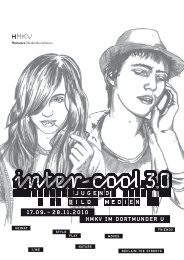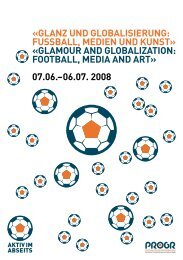Faltblatt – INDUSTRIAL (Research) - HMKV
Faltblatt – INDUSTRIAL (Research) - HMKV
Faltblatt – INDUSTRIAL (Research) - HMKV
Erfolgreiche ePaper selbst erstellen
Machen Sie aus Ihren PDF Publikationen ein blätterbares Flipbook mit unserer einzigartigen Google optimierten e-Paper Software.
CURATING<br />
<strong>INDUSTRIAL</strong><br />
(<strong>Research</strong>)<br />
DE / <strong>INDUSTRIAL</strong> (<strong>Research</strong>) besteht aus einem 22 m<br />
langen Tisch mit Büchern, Schallplatten, Videos und<br />
Objekten. Arbeitsplatz und Forschungslabor zugleich <strong>–</strong><br />
die beiden Kuratoren haben hier Materialien versammelt,<br />
die die kulturellen, ökonomischen, gesellschaftlichen,<br />
technischen oder ästhetischen Auswirkungen der »Gewalt<br />
der Industrie gesellschaft« seit den frühen 70er Jahren<br />
thematisieren. Die BesucherInnen sind eingeladen, lokale<br />
und globale, historische und aktuelle Situationen miteinander<br />
in Verbindung zu setzen.<br />
EN / <strong>INDUSTRIAL</strong> (<strong>Research</strong>) takes the shape of a 22<br />
metre-long table with books, records, videos and various<br />
objects. It is both workplace and research laboratory,<br />
gathering materials collected by the curators around the<br />
cultural, economic, social, technical and aesthetic effects<br />
of »the might of industrial society« since the early 1970s.<br />
Visitors are encouraged to relate local with global, and<br />
historic with current situations.
OBJECTS<br />
DE / OBJEKTE KURATIEREN<br />
Einige wenige <strong>–</strong> durchaus aber sehr beeindruckende <strong>–</strong><br />
Objekte sind Teil von <strong>INDUSTRIAL</strong> (<strong>Research</strong>): so z. B.<br />
eine Kopie der Mitte der 1950er Jahre entstandenen<br />
Glasfenster des Dortmunder Hauptbahnhofs von Hans<br />
Klein auf der südlichen Wand des Ausstellungsraumes<br />
sowie das Ölgemälde ohne Titel (Stahlarbeiter) (1955) von<br />
Otto Honsálek auf der Nordseite <strong>–</strong> übrigens das einzige<br />
»echte« Kunstwerk in dieser Präsentation.<br />
Die von dem Stuttgarter Kunstmaler und Glasschleifer<br />
Hans Klein Mitte der 1950er Jahre entworfenen Glasfenster<br />
des Dortmunder Hauptbahnhofs sind für das<br />
Pro jekt <strong>INDUSTRIAL</strong> (<strong>Research</strong>) von zentraler Bedeutung:<br />
Sie stehen nicht nur für die industrielle Geschichte der<br />
Stadt, sondern auch für eine bestimmte Ästhetik, die viele<br />
Künstler und Musiker der Industrial Music seit Mitte der<br />
1970er Jahre inspiriert hat. Das Ölbild des westfälischen<br />
Expressionisten Otto Honsálek zeigt Stahlarbeiter am<br />
Hochofen. Präsentiert auf einem schwarzen Hintergrund<br />
wirkt es fast so, als würden die leuchtenden Farben die<br />
Hitze des Hochofens ausstrahlen. Beide Objekte <strong>–</strong> die<br />
Glasfenster wie auch das Gemälde <strong>–</strong> stammen aus einer<br />
Zeit, in der die Industrie noch in voller Blüte stand (vor der<br />
Kohlekrise ab 1957). Ihnen gegenüber- bzw. an die Seite<br />
gestellt sind Arbeiterdarstellungen aus den späten 1930er<br />
Jahren aus der Zeitschrift UdSSR im Bau. Glasfenster,<br />
Ölgemälde und Fotografien verkörpern einen für die Zeit<br />
typischen Optimismus.<br />
Die »Gewalt der Industriegesellschaft« (Max Horkheimer<br />
/ Theodor W. Adorno) schreibt sich jedoch nicht<br />
nur in Landschaften ein (wie man in den seriellen Fotografien<br />
von Bernd und Hilla Becher sieht), sondern auch<br />
in das Bewusstsein von Menschen. Die Industrial Music<br />
reagiert seit Mitte der 1970er Jahre in kongenialer Weise<br />
auf diese Gewalt. Über dreißig Schallplatten sind auf dem<br />
Tisch zu hören <strong>–</strong> und zu sehen (interessant ist hier die<br />
Cover gestaltung). Selbstgestaltete Musikcassetten gehörten<br />
in den 1980er Jahren zur technisch-musikalischen<br />
Grundausstattung jedes jungen Menschen. Zu sehen sind<br />
hier über 20 Audiocassetten mit einer eklektischen (aber<br />
immer industriellen) Musikauswahl.<br />
Neben YouTube war eBay für dieses Projekt eine<br />
wahre Fundgrube. Dort erstanden wir mehrere Fabrikmodelle,<br />
wie sie von Modelleisenbahnbauern (hier wird<br />
bewusst nur die männliche Form gewählt) gerne für eine<br />
realistische Landschaftsgestaltung verwendet werden.<br />
Der Märklin-Katalog zeugt noch heute von einem Bewusstsein,<br />
welches eine industrialisierte Landschaft als<br />
Normalzustand annimmt. Zu sehen sind mehrere H0-Fabrikbausätze,<br />
wie z. B. die Farben AG, eine Großbekohlungsanlage,<br />
ein Kran sowie ein Kühlturm. Das um 1955<br />
entstandene selbstgebaute Fabrikmodell mit Schornstein,<br />
für welches Materialien wie Pappe, Toilettenpapier und<br />
eine industrielle Garnrolle verwendet wurden, stammt<br />
jedoch aus einer Privatsammlung. Die in typischem Hammerschlag-Grün<br />
lackierte Stempeluhr der Firma Benzing<br />
repräsentiert das starre Zeitschema des ehemals festen<br />
(und meist unbefristeten) industriellen Arbeitsplatzes.<br />
Daneben sind eine Menge nostalgischer Objekte<br />
zu sehen: so z. B. ein Schmuckbrikett der Brikettfabrik<br />
»Phönix« Mumsdorf, die Skulptur eines Eisengießers<br />
der Eisengießerei Livnica »Kikinda«, die angeblich aus<br />
einer Kneipe in Novi Sad stammt, der Partnerstadt von<br />
Dortmund, eine kleine Karl-Marx-Statue aus Sankt<br />
Petersburg, ein Bierkrug der Dortmunder Unionbrauerei<br />
(Fassungsvermögen 3 l), eine silberne »Glück Auf«-Ziermedaille<br />
mit Schlägel und Eisen des Bergbaumuseums<br />
Karl-Liebknecht-Schacht sowie ein in Zellophan verpacktes<br />
und mit Zierschleife versehenes Stück Steinkohle als<br />
Andenken an eine Grubenfahrt in das Bergwerk Auguste<br />
Victoria in Marl 2010.<br />
Im Epilog findet sich das Aschenbechermodell<br />
»Factory« einer niederländischen Designfirma, das wohl<br />
eher unwissentlich das Logo des Ende der 1970er Jahre<br />
gegründeten englischen Musiklabels Factory Records<br />
kopiert. Subkultur wird Kommerzprodukt <strong>–</strong> und dieses<br />
wiederum zu einem Objekt der Kulturindustrie.<br />
Schauen Sie nun durch die Fenster nach draußen.<br />
Denn das sicherlich größte Objekt im Sinne einer Hinterlassenschaft<br />
des Industriezeitalters ist das Ruhrgebiet<br />
selbst: Sein Relief bzw. seine Topografie resultiert aus<br />
einem mehr als 150-jährigen Terraforming-Prozess.<br />
Durch jahrhundertelangen Kohleabbau ist die Oberfläche<br />
der Region um Dutzende von Metern abgesunken (das<br />
Stadtzentrum von Essen z. B. liegt heute 14 m tiefer als<br />
vor dem Beginn des Kohleabbaus). Solange das Ruhrgebiet<br />
bewohnt ist, muss Grundwasser weggepumpt<br />
werden <strong>–</strong> sonst entstünde hier eine nordrhein-westfälische<br />
Seenplatte. Diese Ewigkeitsschäden machen das<br />
Ruhrgebiet zum »Skulpturengarten« des <strong>INDUSTRIAL</strong><br />
(<strong>Research</strong>) Projektes.<br />
Dr. Inke Arns<br />
EN / CURATING OBJECTS<br />
While <strong>INDUSTRIAL</strong> (<strong>Research</strong>) includes only a few objects,<br />
these are arguably quite impressive, for instance a copy of<br />
the stained glass windows designed in the mid-1950s by<br />
Hans Klein for Dortmund Central Station, here shown on<br />
the south wall of the exhibition space, and the oil painting<br />
Untitled (Steel Workers) (1955) by Otto Honsálek, which can<br />
be seen on the northern wall (incidentally, the only »genuine«<br />
artwork in this presentation).<br />
The stained glass windows by the Stuttgart-born painter<br />
and glass engraver Klein are of central importance to<br />
<strong>INDUSTRIAL</strong> (<strong>Research</strong>) because they epitomise not only<br />
the city’s industrial history but also a certain aesthetic<br />
which has been inspiring numerous artists and musicians<br />
since the mid-1970s. The painting by the Westphalian<br />
Expressionist Honsálek depicts steel workers at the furnace.<br />
Appearing on a black background, the bright colours<br />
literally radiate the heat of the furnace. Both objects <strong>–</strong> the<br />
windows and the painting <strong>–</strong> date from a time when the<br />
industry was in full bloom (before the coal crisis that<br />
started in 1957). In the exhibition space they are displayed<br />
opposite or next to images of workers from the 1930s<br />
taken from the magazine USSR in Construction. Stained<br />
glass windows, oil paintings and photographs embody the<br />
optimism of the day.<br />
The »might of industrial society« (Max Horkheimer /<br />
Theodor W. Adorno) not only inscribes itself in the landscape<br />
(as can be seen in the serial photographs of Bernd<br />
and Hilla Becher) but also in the minds of its inhabitants.<br />
Since the mid-1970s Industrial Music has been a congenial<br />
reaction to this violence. More than thirty records may<br />
here be listened to <strong>–</strong> and seen (look out for the album covers!).<br />
In the 1980s self-styled music cassettes were part<br />
and parcel of any teenager’s technological and musical<br />
life; our little collection presents twenty audio cassettes<br />
covering an eclectic (but always »industrial«) selection of<br />
music.<br />
Besides YouTube, eBay was a real treasure trove for<br />
this project. This is where we found several scale models<br />
of factories as commonly used by model railway enthusiasts<br />
(a term reserved for men, it seems) to create realistic<br />
landscapes. Even today the Märklin catalogue bears<br />
witness to a state of mind in which industrial landscapes<br />
are considered to be the norm. We present several H0<br />
factory assembly kits, among others of Farben AG, a<br />
large coal handling facility, a crane and a cooling tower.<br />
The homebuilt model of a factory with smokestack from<br />
around 1955, made using materials such as cardboard,<br />
toilet paper and an industrial thread reel, is however<br />
from a private collection. The punch-clock, painted in the<br />
characteristic Hammerite green of the Benzing company,<br />
symbolises the rigid schedules of past industrial jobs as a<br />
stable (and mostly open-ended) form of employment.<br />
Our collection furthermore comprises a range of<br />
nostalgic objects such as an ornamental briquette from<br />
the briquette manufacturer »Phönix« Mumsdorf; the<br />
sculpture of a foundryman from the Livnica »Kinkinda«<br />
foundry which is alleged to come from a bar in Novi Sad,<br />
Dortmund’s partner city; a small statue of Karl Marx<br />
from Saint Petersburg; a beer mug from the Dortmunder<br />
Unionbrauerei (with a capacity of 3 litres); a decorative<br />
»lucky charm« silver medal with hammer and chisel from<br />
the Mining Museum Karl-Liebknecht-Schacht; and not<br />
least a piece of coal wrapped in cellophane and ribbon as<br />
a souvenir of an underground visit of the Auguste Victoria<br />
Mine in Marl in 2010.<br />
As an epilogue visitors will find a tiny »Factory« ashtray<br />
from a Dutch design company featuring a (probably<br />
unintentional) copy of the logo of the English label Factory<br />
Records, which was founded in the late 1970s. Subculture<br />
is turned into a commercial product, which in turn<br />
becomes an object of the cultural industry.<br />
Finally, we encourage you to look out of the windows.<br />
By no doubt the largest object in terms of the legacy of<br />
the industrial age is the Ruhr area itself. Its relief and<br />
topography are the result of more than 150 years of<br />
»terraforming«. Centuries of coal mining have caused the<br />
region’s ground to drop by dozens of metres (Essen city<br />
centre, for instance, now lies 14 metres lower than at the<br />
inception of coal mining). As long as the Ruhr is inhabited,<br />
the groundwater will need to be pumped off if the area<br />
is not to turn into a North-Rhine Westphalian version of<br />
the Lake District. In light of these eternal damages, the<br />
Ruhr area can be said to be the »sculpture garden« of the<br />
<strong>INDUSTRIAL</strong> (<strong>Research</strong>) project.<br />
Dr. Inke Arns<br />
BOOKS<br />
DE / BÜCHER KURATIEREN<br />
Der Schwerpunkt des Projektes <strong>INDUSTRIAL</strong> (<strong>Research</strong>)<br />
liegt auf dem Zeitraum 1973 bis heute. Jedoch gab es<br />
auch vorher, insbesondere seit dem Beginn des 20. Jahrhunderts<br />
<strong>–</strong> also noch während der Blütezeit der Schwerindustrie<br />
in den alten Industrieländern <strong>–</strong> signifikante<br />
Reflexionen der, und künstlerische Reaktionen auf die<br />
Industrialisierung.<br />
Im Prolog (1922 <strong>–</strong> 1973) haben wir einige dieser außergewöhnlichen<br />
Projekte zusammengestellt. Insbesondere<br />
in der Sowjetunion, welche ja ab 1917 eine im Vergleich<br />
zum Westen forcierte und rasend schnelle Industrialisierung<br />
durchlief (die auch entsprechende Opfer forderte),<br />
lassen sich Beispiele für solche Reaktionen finden. Bereits<br />
1922 führte Arseni Avraamov in Baku die Symphonie<br />
der Sirenen auf <strong>–</strong> eine Komposition für Fabriksirenen und<br />
die Nebelhörner der gesamten Kaspischen Flotte, die er<br />
mit Hilfe von Signalflaggen dirigierte. Magnitogorsk ist ein<br />
anderer Kondensationspunkt dieses Prologs: Die sowjetische<br />
Stadt <strong>–</strong> die zunächst nichts weiter als ein aus dem<br />
Nichts entstandenes gigantisches Stahlwerk in der Steppe<br />
hinter dem Ural war <strong>–</strong> wurde im ersten Jahr der Weltwirtschaftskrise<br />
(1929 <strong>–</strong> 1932) gegründet und maßgeblich von<br />
dem deutschen Architekten Ernst May gebaut. Von 1931<br />
bis 1936 lebte und arbeitete hier der Amerikaner John<br />
Scott, der einen beeindruckenden Augenzeugenbericht<br />
über seine Zeit in Magnitogorsk verfasste.<br />
Mit der Kohlekrise ab 1957 <strong>–</strong> 58 kündigte sich das Ende<br />
des Industriezeitalters in den alten Industrienationen des<br />
Westens an. Die Kohlekrise führte zu einer Dauerkrise<br />
der Montanindustrie, die in den folgenden Jahrzehnten<br />
zu Schließungen von Zechen, Hochöfen und Stahlwerken<br />
führte. Riesige Industrieareale werden zu Ruinen. So wird<br />
aber gleichzeitig ein neuer (durchaus ästhetischer) Blick<br />
auf diese Strukturen möglich. Es entsteht ein Bewusstsein<br />
für den Status als kulturelles Erbe <strong>–</strong> sowie der Begriff der
»Industriekultur«. In den 1960er Jahren begannen Bernd<br />
und Hilla Becher systematisch alte Industriearchitekturen<br />
zu fotografieren. Ihre ersten Bücher mit seriellen<br />
Fotografien erschienen 1977. <strong>INDUSTRIAL</strong> (<strong>Research</strong>)<br />
versammelt nicht nur einige Fotos, sondern (fast) alle bis<br />
heute erschienenen Foto-Bände der Bechers.<br />
Die Fabrikgeräusche, die Arseni Avraamov bereits<br />
1922 verwendete, scheinen eine direkte Vorwegnahme<br />
der ein halbes Jahrhundert später entstehenden Industrial<br />
Music zu sein. Allerdings sind diese Sounds in der<br />
Industrial Music keine Chiffre mehr für den Enthusiasmus<br />
des Aufbaus. Eher sind sie Ausdruck der »Gewalt<br />
der Industriegesellschaft« (Horkheimer / Adorno). Die<br />
als Kunstprojekte gestarteten britischen Formationen<br />
Cabaret Voltaire (1974) und Throbbing Gristle (1976)<br />
begründen Mitte der 1970er Jahre diese Musikrichtung<br />
(die Adorno, dem schon Jazzmusik suspekt war, bestimmt<br />
zutiefst abgelehnt hätte). In den letzten zehn Jahren sind<br />
Bücher zu einzelnen Bands erschienen, wie z. B. Simon<br />
Fords Buch zu Throbbing Gristle (1999), Inke Arns’ Bücher<br />
zur NSK (2002/2003), Alexei Monroes Buch zu Laibach<br />
(2005) oder Max Dax’ und Robert Defcons Buch zu den<br />
Einstürzenden Neubauten (2006). In den USA erschienen<br />
mit Re/Search 6/7: Industrial Culture Handbook (1983) und<br />
Mark Derys Escape Velocity <strong>–</strong> Cyberculture at the End of the<br />
Century (1996) relativ früh erste Dokumentationen bzw.<br />
der Versuch einer Einordnung von Industrial als Vorbote<br />
des beginnenden Informationszeitalters. 2013 erschien<br />
mit Alexander Reeds Assimilate: A Critical History of Industrial<br />
Music die vermutlich erste akademische Abhandlung<br />
zu dem Thema.<br />
Ein weiterer Fokus ist die amerikanische Stadt Detroit.<br />
Erstaunlich viele Bücher sind in den letzten zehn Jahren<br />
über diese früher auch als Motown (Motor Town) bekannte<br />
Stadt erschienen, die während der Krise der Automobilwirtschaft<br />
in den 1980er Jahren zum Sinnbild des Unter<br />
gangs einer Industriestadt wurde. 2013 ist die Stadt<br />
endgültig bankrott und überlegt, das Gemälde Der Traum<br />
der Menschheit von Tintoretto und weitere 37 Kunstwerke<br />
des Detroit Institute of Arts im Wert von 2,5 Milliarden<br />
Dollar zu verkaufen.<br />
Ein Teil der leer stehenden Ruinen des Industriezeitalters<br />
kann umgenutzt werden, temporär oder auch<br />
permanent. 1994 findet z. B. in Leipzig die 2. Medienbiennale<br />
in dem Gebäude der erst 1992 von der Treuhand<br />
stillgelegten VEB Buntgarnwerke Leipzig statt. 1998<br />
zeigt der <strong>HMKV</strong> in der Ruine der ehemaligen Dortmunder<br />
Union-Brauerei (1994 geschlossen) die spektakuläre<br />
Ausstellung Reservate der Sehnsucht. Diese Ausstellung<br />
gab den Anstoß für den Umbau des Dortmunder U in<br />
das 2010 eröffnete Zentrum für Kunst und Kreativität. In<br />
den Folgejahren wird das Reserveteillager des ehemaligen<br />
Hörder Hochofenwerkes auf Phoenix-West zum<br />
Veranstaltungssort: Von 2003 <strong>–</strong> 2010 nutzt der <strong>HMKV</strong><br />
die PHOENIX Halle für seine Ausstellungen (dokumentiert<br />
durch verschiedene Kataloge). In der Folge setzen<br />
sich verschiedene internationale Projekte mit dem Erbe<br />
des Industriezeitalters auseinander: Usine. Le regard de<br />
soixante-treize artistes contemporains sur l’usine (2003),<br />
Industriestadtfuturismus. 100 Jahre Wolfsburg / Nowa Huta<br />
(2007), INDUNATURE (2009), 1rst Ural Industrial Biennial of<br />
Contemporary Art: Shockworkers of the Mobile Image (2010),<br />
Tarnów <strong>–</strong> 1000 Years of Modernity (2011), <strong>INDUSTRIAL</strong> on<br />
Tour (2011) und Manifesta 9 (2012).<br />
Kultur ist jedoch nur eine Option für die postindustrielle<br />
Nutzung von Industrieruinen. Interessanter ist es<br />
jedoch, die neuen Industrien und die von ihnen geschaffenen<br />
Arbeitsverhältnisse zu untersuchen: Der von Trebor<br />
Scholz herausgegebene Band Digital Labor: The Internet<br />
as Playground and Factory (2013) enthält einen Aufsatz zu<br />
Amazons Mechanical Turk (das Internet als Fließband<br />
für ungelernte Fabrikarbeit), Work, Work, Work (2010)<br />
beschäftigt sich <strong>–</strong> als ein Beispiel unter vielen <strong>–</strong> mit<br />
zu nehmend prekären Arbeitsverhältnissen (das letzte<br />
HTRK-Album trägt übrigens denselben Titel) und das von<br />
General Electric verfasste Positionspapier zum Industrial<br />
Internet (2013) betrachtet selbiges als verlängerte Werkbank.<br />
Der abschließende Epilog ist gleichzeitig ein Prolog<br />
zu den Entwicklungen, die uns zukünftig in China und <strong>–</strong><br />
wenn dort die Lohnkosten zu hoch geworden sein werden<br />
<strong>–</strong> in Südostasien erwarten.<br />
Dr. Inke Arns<br />
EN / CURATING BOOKS<br />
The <strong>INDUSTRIAL</strong> (<strong>Research</strong>) project focuses on the era<br />
from 1973 to the present day. But well before that time,<br />
and more particularly since the beginning of the twentieth<br />
century <strong>–</strong> in other words, the heyday of heavy industry in<br />
the old industrial nations <strong>–</strong> industrialisation prompted<br />
important reflections and artistic reactions.<br />
In the Prologue (1922 <strong>–</strong> 1973) we have brought together<br />
a few of these extraordinary projects. In the Soviet Union,<br />
in particular, which from 1917 onwards underwent a forceful<br />
and rapid process of industrialisation compared to the<br />
West (a process which, accordingly, came at a great cost<br />
for many people), examples for such reactions are rife. As<br />
early as 1922 Arseny Avraamov created the Symphony of<br />
Sirens in Baku, a composition for factory sirens and the<br />
foghorns of the entire Caspian Fleet, which he conducted<br />
with signal flags. Magnitogorsk is another focus of the<br />
prologue: this Soviet city <strong>–</strong> initially no more than a gigantic<br />
steel mill built from scratch in the steppes behind the<br />
Ural Mountains <strong>–</strong> was founded in the first year of the Great<br />
Depression (1929 <strong>–</strong> 1932) and designed to a large degree<br />
by the German architect Ernst May. The American writer<br />
John Scott produced an impressive account of his time in<br />
Magnitogorsk, where he lived from 1931 to 1936.<br />
The coal crisis of 1957/58 foreshadowed the end of<br />
the industrial era in the traditional industrial nations<br />
in the West. It caused a permanent crisis of the mining<br />
industry, which would see countless pits, furnaces and<br />
mills being shut down over the following decades. Huge<br />
industrial areas were turned into ruins. At the same time,<br />
this allowed for a new (often aesthetic) perspective on the<br />
now defunct infrastructures, raising general awareness<br />
for the relevance of industrial buildings as reflected in<br />
the emergence of a new term: »industrial heritage«. In<br />
the 1960s Bernd and Hilla Becher started systematically<br />
photographing old industrial buildings. Their first books<br />
with serial photographs were published in 1977. Rather<br />
than a few of these images, <strong>INDUSTRIAL</strong> (<strong>Research</strong>) has<br />
gathered (almost) all photographic volumes published by<br />
the Bechers.<br />
The factory noises used by Avraamov in 1922 appear to<br />
anticipate Industrial Music by half a century. Yet now these<br />
same sounds no longer stand for an enthusiastic start to<br />
a new era, but for the »might of industrial society« (Max<br />
Horkheimer / Theodor W. Adorno). Formed respectively in<br />
1974 and 1976 as art projects, the British bands Cabaret<br />
Voltaire and Throbbing Gristle largely invented this musical<br />
genre in the mid-1970s (which Adorno, who considered<br />
even jazz to be suspicious, would surely have repudiated).<br />
In the past ten years various authors have written extensively<br />
about these bands, among whom Simon Ford on<br />
Throbbing Gristle (1999), Inke Arns on NSK (2002/2003),<br />
Alexei Monroe on Laibach (2005) and Max Dax and Robert<br />
Defcon on Einstürzende Neubauten (2006). In the USA the<br />
publication of Re/Search 6/7: Industrial Culture Handbook<br />
(1983) and Mark Dery’s Escape Velocity <strong>–</strong> Cyberculture at<br />
the End of the Century (1996) are early documentations and<br />
attempts at defining Industrial Music as a harbinger of the<br />
nascent information age. Finally, in 2013, Alexander Reed<br />
published Assimilate: A Critical History of Industrial Music,<br />
presumably the first academic treatise on the subject.<br />
Another focus of our selection lies on the American<br />
town of Detroit. A surprising number of books have been<br />
written in the past ten or so years about the city formerly<br />
known as Motown (short for »Motor Town«), which during<br />
the car manufacturing crisis in the 1980s epitomised the<br />
demise of large industrial towns. Today it is effectively<br />
bankrupt and considers selling Tintoretto’s The Dreams<br />
of Men and 37 other artworks from the Detroit Institute of<br />
Arts worth a combined $2.5bn.<br />
Some of the West’s industrial relics were temporarily<br />
or permanently converted for other purposes. The 2nd<br />
Media Biennale in Leipzig in 1994, for instance, took place<br />
in the building of the former GDR national-owned yarn<br />
mill VEB Buntgarnwerke Leipzig, which had only been<br />
shut down by the German National Property Trust Treuhand<br />
two years previously. In 1998 the <strong>HMKV</strong> presented<br />
the spectacular exhibition Reservate der Sehnsucht in the<br />
remains of the former Dortmunder Union Brewery (closed<br />
down in 1994), which prompted the refurbishment of the<br />
Dortmunder U into a Centre for Art and Creativity opened<br />
in 2010. In the following years the spare parts depot of the<br />
former steel mill Phoenix-West in Dortmund-Hörde were<br />
used as an event venue: from 2003 to 2010 the <strong>HMKV</strong> used<br />
the PHOENIX Halle for its exhibitions (as documented<br />
in various catalogues). Since then, various international<br />
projects have addressed the legacy of the industrial age,<br />
among which Usine. Le regard de soixante-treize artistes<br />
contemporains sur l’usine (2003), Industriestadtfuturismus.<br />
100 Jahre Wolfsburg / Nowa Huta (2007), INDUNATURE<br />
(2009), 1rst Ural Industrial Biennial of Contemporary Art:<br />
Shockworkers of the Mobile Image (2010), Tarnów <strong>–</strong> 1000<br />
Years of Modernity (2011), <strong>INDUSTRIAL</strong> on Tour (2011) and<br />
Manifesta 9 (2012).<br />
But culture is only one option among others for the<br />
post-industrial conversion of this heritage. It might be<br />
even more worthwhile to explore the new industries and<br />
the working conditions they create: the anthology Digital<br />
Labor: The Internet as Playground and Factory (2013) edited<br />
by Trebor Scholz includes an essay on Amazon Mechanical<br />
Turk (the Internet as a conveyer belt for unskilled factory<br />
work); Work, Work, Work (2010) is one of many books to<br />
address the issue of precarious working conditions (incidentally,<br />
it is also the title of HTRK’s latest album); and the<br />
policy paper Industrial Internet (2013) drafted by General<br />
Electric looks at the Web as an extended workbench. The<br />
concluding Epilogue is simultaneously a prologue of the<br />
developments which we may expect in coming years in<br />
China and <strong>–</strong> once wages there are too high <strong>–</strong> in Southeast<br />
Asia.<br />
Dr. Inke Arns<br />
VIDEOS<br />
DE / YOUTUBE KURATIEREN<br />
Mit mehr als hundert Stunden Uploads pro Minute und<br />
einer Milliarde Besucher jeden Monat ist YouTube heute<br />
die drittgrößte Webseite im Internet nach Facebook und<br />
Google. Lady Gaga hat ihren eigenen Kanal dort, der<br />
bereits über eine Milliarde Mal angeklickt wurde, und zu<br />
jedem Thema findet sich ein entsprechender Film (außer<br />
Pornografie, denn YouTube ist eher prüde). Aber für den,<br />
der bereit ist länger zu suchen, ist YouTube nicht nur<br />
Entertainment, sondern vielmehr ein bizarres (und ziemlich<br />
unorganisiertes) Archiv.<br />
Nehmen Sie den Begriff, der uns hier interessiert:<br />
Industrial Music. Fügen Sie die Namen einiger Bands oder<br />
Songs aus den 1980ern hinzu und schon finden Sie einen<br />
wunderschönen, von einer VHS-Kassette abkopierten Clip<br />
zu Nag Nag Nag von Cabaret Voltaire, ferner eine seltene<br />
Live-Aufnahme von Kollaps der Einstürzenden Neubauten<br />
und ein ähnliches Bootleg-Video einer verstörenden Darbietung<br />
des Songs Discipline von Throbbing Gristle. Wenn<br />
man weiter sucht, stößt man auf einen Film eines Fans<br />
mit typischen Video-Effekten aus den 1980ern zu SPKs<br />
grandiosem In Flagrante Delicto und, aus jüngerer Zeit,<br />
ein Video zu The Industrialist von Fear Factory. Angesichts<br />
solcher Resultate erklärt es sich von selbst, dass YouTube
das MTV des dritten Jahrtausends ist. Schließlich deckt es<br />
nicht nur alle Stilrichtungen, Genres und Subgenres von<br />
Musik ab, sondern lässt den Benutzer zudem wählen, was<br />
und wann er sich etwas anhören (und anschauen) möchte.<br />
Vergessen wir nicht, dass man vor ein paar Jahren noch<br />
endlose Werbefilmchen über sich ergehen lassen musste,<br />
bevor etwas Interessantes im Fernsehen kam. Heute<br />
hinge gen geht es eher darum, solange zu suchen, bis man<br />
die sprichwörtliche Perle im Meer der Filme gefunden<br />
hat.<br />
Doch das Suchen (oder Forschen) kann sich auch als<br />
heitere Angelegenheit entpuppen, etwa wenn man Videos<br />
ausfindig macht, die ansonsten nur von ein paar hundert<br />
Menschen gesehen wurden. So haben zum Beispiel,<br />
während ich dies schreibe, gerade mal 2.712 Personen<br />
eine vom DDR-Staatsfernsehen produzierte Dokumentation<br />
über Eisenhüttenstadt gesehen, während ein Porträt<br />
von Detroit und seiner Industrie aus dem Jahr 1961<br />
zehnmal öfter gesichtet wurde. (Bedeutet dies, dass die<br />
Geschichte der USA mehr Menschen interessiert als die<br />
eines Landes, das vor zwanzig Jahren verschwand?) 1939<br />
machte der Automobilhersteller Ford regelrechte Propaganda<br />
für seine Produkte und erklärte die Fortschrittlichkeit<br />
von Hyperproduktivität, während ein anderer Film die<br />
Mischung aus Tradition und High-Tech der japanischen<br />
Industrie im Jahr 1964 zeigt. Diesen Filmen ist gemeinsam,<br />
dass sie unbeabsichtigterweise darlegen, dass die<br />
Industrie vor allem von ihrer eigenen (schnellen) Überholtheit<br />
lebt.<br />
Folgen wir der Verbindung zwischen Städten und<br />
Industrie, schickt uns der Suchbegriff »Sochaux« (der<br />
französische Produktionsstandort von Peugeot) auf eine<br />
Zeitreise mittels einer Werbereportage aus dem Jahr<br />
1954, die uns die Stadt als Lebens- und Arbeitsparadies<br />
schildert. Der Film beschreibt die Herstellung eines Fahrzeugs<br />
so detailliert, dass auch nichtfranzösischsprachige<br />
Zuschauer rundum aufgeklärt werden. Lehrmaterial gibt<br />
es im Übrigen auf YouTube zuhauf, von Sendungen zur<br />
Geschichte der industriellen Revolution und der Katastrophe<br />
von Bhopal (1984) bis hin zu Zeichentrickfilmen<br />
für Kinder über die Herstellung von Schrauben oder die<br />
bekannten TED-Vorträge einer Wissenschaftlerin, die das<br />
soziale Umfeld von Arbeitern in China beleuchtet, um nur<br />
ein Beispiel zu nennen.<br />
Sucht man nach altem Filmmaterial wie Schwarzweißfilmen<br />
ohne Ton, in denen Maschinen zu sehen sind, landet<br />
man logischerweise bei Fritz Langs Metropolis (1927).<br />
Und, last but not least, wenn Sie die Nachrichten von<br />
Vorvorgestern verpasst haben, können Sie auf YouTube<br />
die Eröffnung der Kulturhauptstadt Europas RUHR.2010<br />
in einer bekannten Fabrik in Essen noch einmal verfolgen.<br />
Seien Sie also vorsichtig, denn alles was Sie tun, könnte<br />
auf YouTube landen. Eine Frage bleibt dennoch offen: Wer,<br />
so wundere ich mich, hat bloß die Zeit, all diese alten<br />
Filmrollen aufzuspüren, sie zu digitalisieren und online zu<br />
setzen?<br />
EN / CURATING YOUTUBE<br />
With one hundred hours of new material uploaded every<br />
minute and one billion visitors every month, YouTube has<br />
become the third-largest website on the Internet after<br />
Facebook and Google. Lady Gaga has her own channel<br />
there, which has attracted more than one billion views,<br />
and whatever your query, you are likely to find a corresponding<br />
film (except for pornography, as YouTube is rather<br />
prudish). But if you are ready to dig, and dig again, it is<br />
not just a place for entertainment but a twisted (and quite<br />
disorganised) archive.<br />
Let us start with our topic of interest: Industrial Music.<br />
Add the names of bands or songs from the 1980s, and<br />
you will come across Cabaret Voltaire’s Nag Nag Nag on<br />
a film transferred from VHS tape, a rare live recording of<br />
Einstürzende Neubauten’s Kollaps, and a similar bootleg<br />
video showing a disturbing performance of Throbbing<br />
Gristle’s Discipline. If you go deeper, you will find a clip<br />
with characteristic 1980s video effects made by a fan to<br />
SPK’s fantastic track In Flagrante Delicto and, closer to us,<br />
a video of Fear Factory’s The Industrialist. In light of such<br />
finds, it becomes obvious why YouTube is the MTV of the<br />
third millennium, featuring all styles, genres and subgenres<br />
of music, while also offering the possibility to choose<br />
what and when you want to hear (and see) something.<br />
Remember, only a few years ago you had to sit through<br />
commercials before something interesting came up on TV.<br />
Today, on the other hand, the challenge is to navigate until<br />
you find the rare pearl in an ocean of films.<br />
But (re-)searching can also be amusing, particularly<br />
when, in the process, you manage to unearth videos<br />
that have only been seen by a few hundred people. For<br />
instance, as I am writing these lines, only 2,712 viewers<br />
have watched a GDR State TV documentary about Eisenhüttenstadt,<br />
while a portrait of Detroit and its industry<br />
from 1961 has attracted ten times more visitors. (Does<br />
this imply that the history of the USA seems more interesting<br />
to the general public than a country that disappeared<br />
twenty years ago?) In 1939 the automobile manufacturer<br />
Ford produced genuine propaganda films for its products,<br />
explaining how the key of progress lies in hyper-productivity,<br />
while another film, from 1964, reflects on the combination<br />
of tradition and high-tech in Japanese industry.<br />
But what this historical footage has in common is that it<br />
unwittingly shows that industry primary draws on its own<br />
(fast) obsolescence.<br />
If you want to chart the link between towns and industry,<br />
Sochaux (the city where the French Peugeot factories<br />
are located) is an obvious place to start, with an infomercial<br />
from 1954 describing how great it is to live (and work)<br />
there. The film is so didactic that even if you do not speak<br />
French, you will eventually know the ins and outs of car<br />
manufacturing. Talking of learning programmes, this is<br />
another forte of YouTube, where anything is available from<br />
a series on the history of the Industrial Revolution or the<br />
Bhopal gas tragedy (1984) to cartoons for kids showing<br />
how a metal screw is produced or the famous TED lectures<br />
in which a researcher discusses the social situation<br />
of workers in China, to name but one example.<br />
When looking for older material such as silent blackand-white<br />
films involving machines, you will logically<br />
stum ble upon an extract from Fritz Lang’s Metropolis<br />
(1927). And last but not least, if you missed the evening<br />
news from the day before yesterday, YouTube is a great<br />
way of finding footage, say, of the opening of the European<br />
Capital of Culture RUHR.2010 in a well-known factory in<br />
Essen. So be careful: everything you do could end on the<br />
Tube. But one question remains: who, I wonder, has the<br />
time to track down these old films in rusty cans, digitise<br />
them and put them online?<br />
Thibaut de Ruyter<br />
RECORDS<br />
DE / SCHALLPLATTEN KURATIEREN<br />
Streiten gehört zu den Lieblingsbeschäftigungen von<br />
Schall plattensammlern und Musikfans. Um zu verstehen,<br />
wie Musikliebhaber Tage damit verbringen können, Listen<br />
zu erstellen, mit denen sie das, was man ihres Erachtens<br />
gehört haben muss, festlegen, ausschließen, wählen und<br />
ordnen, sollte man Nick Hornbys Roman High Fidelity<br />
(1995) lesen. Demzufolge dürfte jeder Kenner, der die hier<br />
präsentierte Auswahl von Platten inspiziert, zahlreiche<br />
Gründe finden, anderer Meinung als die Kuratoren zu<br />
sein. Doch kuratieren bedeutet (unter anderem) eine Auswahl<br />
treffen, um die Mehrzahl der Besucher mit einem<br />
Thema vertraut zu machen. Dies erklärt, wieso man in<br />
unserer Sammlung, ungeachtet dessen, dass der Ende<br />
der 1970er Jahre vom Künstler und Komponist Monte<br />
Cazazza geprägte Begriff »Industrial Music« zunächst nur<br />
die musikalischen Experimente einer bestimmten Band<br />
(Throbbing Gristle) beschrieb, auch unerwartete Platten<br />
wie Unknown Pleasures (1979) von Joy Division findet.<br />
Letztere kann man zwar nicht wirklich als Industrial Music<br />
beschreiben, doch das Label, auf dem sie erschien, heißt<br />
Factory, und am Anfang eines Titels (Insight) hört man<br />
deutlich einen Industrielift in den Abgrund rattern.<br />
In Europa waren die 1970er Jahre stark vom Zerfall<br />
der Schwerindustrie geprägt. Es ist also kein Zufall, dass<br />
eine deutsche Band sich Kraftwerk nannte und sich aus<br />
der heimeligen Welt der Synthesizer in das hammerharte<br />
Milieu des Metal wagte, wie zu hören im Song Metal<br />
On Metal auf dem bahnbrechenden Album Trans Europe<br />
Express (1977). Zur gleichen Zeit setzten in England<br />
Cabaret Voltaire ebenfalls Synthesizer ein, schlugen<br />
dabei aber eine ungleich rauhere und brutalere Gangart<br />
ein: Baader-Meinhof ist kein Popsong, sondern greift auf<br />
ein ewiges Merkmal der Industrial Music zurück, nämlich<br />
Provokation anhand einer mehr oder weniger subtilen<br />
Aneignung von Symbolen, Bildern und Figuren von den<br />
Rändern des politischen Spektrums.<br />
Damit sind wir auch schon in den 1980er Jahren und<br />
bei den Klassikern von Laibach angelangt, etwa Krst Pod<br />
Triglavom / Baptism Under The Triglav (1987) mit seinem<br />
pseudowagnerianischen Kriegsgerassel, aber auch bei<br />
den Einstürzenden Neubauten, die schnell zum Symbol<br />
einer alternativen Jugend in einer alternativen Welt<br />
avan cierten: West-Berlin, einer von einer Betonmauer<br />
umgebenen Insel. Ihr treffend betiteltes Album Kollaps<br />
(1981) ist ein authentisches Beispiel von hämmerndem<br />
und schreiendem Metal, schafft es dabei aber sogar<br />
schön zu klingen.<br />
Jahre später trafen die Einstürzenden Neubauten den<br />
DDR-Dramatiker Heiner Müller, dessen Hamletmaschine<br />
(dem wir die Verse »Ich will eine Maschine sein. Arme zu<br />
greifen Beine zu gehn kein Schmerz kein Gedanke« entnommen<br />
haben) sie als Hörspiel (1991) kreierten. Dieses<br />
Werk markiert eine Wende ihres Sounds hin zu mehr<br />
Melodie und Poesie, ohne dabei seine rohe Energie einzubüßen.<br />
Der Sänger der Band, Blixa Bargeld, nahm zudem<br />
mit dem Elektromusiker und Künstler Alva Noto / Carsten<br />
Nicolai das Album Mimikry (2010) auf, wo die beiden eine<br />
Gewalt freisetzen, die längst vergessen schien. Als jüngeres<br />
Beispiel für die Zusammenarbeit zwischen »Industrialisten«<br />
der ersten Generation und jüngeren Musikern<br />
finden wir Carter Tutti Void, zwei Mitglieder der mythischen<br />
Throbbing Gristle, die im Verbund mit Nikki Colk<br />
von Factory Floor mit Transverse eines der besten Alben<br />
aus dem Jahr 2013 abgeliefert haben.<br />
In den 1990er Jahren verzweigte sich die Industrial<br />
Music in zahlreiche Sparten. Manche Musiker führten<br />
ihre Erkundungen klassischer und traditioneller Musik<br />
fort (SPK und ihr wegweisendes Album Zamia Lehmanni<br />
[Songs of Byzantine Flowers], 1986), andere befanden,<br />
Gitarren seien die einzige Lösung, um einen von Gewalt<br />
durchtränkten Sound zu erzeugen (Caspar Brötzmann<br />
Massakers Album Der Abend der schwarzen Folklore,<br />
1992), während noch andere sich ganz ins Feld der elektronischen<br />
Musik schlugen, mit seinen ständig wiederholten<br />
Beats, die entfernt an Fabriklärm gemahnen (Mekano<br />
Turbo). Doch was alle diese Bands und Alben verbindet,<br />
ist eine besondere Atmosphäre: Ob mit oder ohne Beats,<br />
Elektronik oder Stimmen sind sie tiefgründig, düster und<br />
freudlos. Dieser pessimistische Grundton erklärt, wieso<br />
auch Bands wie HTRK oder Raime <strong>–</strong> die kein Fan von<br />
Industrial Music im Traum zu Vertretern dieser Musikrichtung<br />
zählen würde <strong>–</strong> ein Platz in unserem Archiv<br />
eingeräumt wurde.<br />
Manchmal ist aber auch bloß ein schönes Cover der<br />
ausschlaggebende Grund, dass ein Album es in unsere<br />
Auswahl geschafft hat, wobei Songs Of Love And Hate<br />
(1996) von Godflesh ein offensichtliches Beispiel sein<br />
dürfte. Dabei ist die Musik auf diesem Album keineswegs<br />
sanft und schön, und auch Conqueror (2007) von Jesu hört<br />
man an, dass Justin K. Broadrick, der für beide Bands<br />
Thibaut de Ruyter
verantwortlich zeichnet, kein selbstzufriedener Zeitgenosse<br />
ist.<br />
Die Welt hat sich seit den 1970ern und der Ölkrise<br />
nicht radikal verändert. Es ist halt nur ein anderer Krieg,<br />
eine andere Konjunkturflaute, ein andere Krise. Genau<br />
deshalb brauchen wir eine Alternative zum sorglosen<br />
Mainstream, den uns der Rundfunk tagtäglich zwischen<br />
zwei Werbungen auftischt. Sie mögen sie »industriell«<br />
nennen, ich jedenfalls nenne sie schlicht »realistisch«.<br />
Thibaut de Ruyter<br />
EN / CURATING RECORDS<br />
Arguing is a favourite pastime among record collectors<br />
and music buffs. To understand how people who share a<br />
passion for music can spend days making lists, including,<br />
excluding, selecting and ordering what, in their opinion,<br />
is worth listening to, you should read Nick Hornby’s novel<br />
High Fidelity (1995). Arguably, any specialist looking at<br />
the selection of records presented here will find countless<br />
reasons to disagree with the curators. But curating<br />
is (at least partly) about making choices to familiarise<br />
larger audiences with a given subject. This explains why,<br />
regard less of the fact that the term »Industrial Music«<br />
was coined in the late 1970s by the artist and composer<br />
Monte Cazazza to describe the musical experimentations<br />
of one particular band (Throbbing Gristle), our selection<br />
includes unlikely albums such as Joy Division’s Unknown<br />
Pleasures (1979). True, this is not Industrial Music strictly<br />
speaking, but the record company who released it was<br />
called Factory, and at the beginning of the track (Insight),<br />
one clearly hears the sound of a factory lift descending<br />
into the abyss.<br />
In Europe the 1970s were deeply marked by the demise<br />
of heavy industry. It is therefore not a coincidence<br />
that a certain German band should have called itself<br />
Kraftwerk (power plant) and ventured from the cosy world<br />
of synthesisers into the hard-hitting universe of metal, as<br />
can be heard on Metal On Metal from their groundbreaking<br />
album Trans Europe Express (1977). Meanwhile in England<br />
Cabaret Voltaire were also using synthesisers, though for<br />
much rougher and violent purposes: Baader-Meinhof is<br />
no pop song, touching on what is the matrix of Industrial<br />
Music: provocation through the more or less subtle appropriation<br />
of symbols, images and figures from the extremes<br />
of the political spectrum.<br />
This leads us straight to the 1980s and the classic<br />
albums by Laibach, among which Krst Pod Triglavom /<br />
Baptism Under The Triglav (1987) and its pseudo-Wagnerian<br />
martial tunes, but also to Einstürzende Neubauten,<br />
who became the symbol for an alternative youth living in<br />
an alternative world <strong>–</strong> West Berlin, an island surrounded<br />
by a concrete wall. Their aptly titled album Kollaps (1981)<br />
is a great example of hammering and crying metal, yet<br />
manages to retain a real sense of beauty.<br />
Years later Einstürzende Neubauten met the GDR<br />
playwright Heiner Müller and created a radio play (1991)<br />
around his text Hamletmaschine (from where we took the<br />
quote »I want to be a machine. Arms to grasp legs to walk<br />
no pain no thoughts«). This work marked a turn in their<br />
sound, which became more melodic and poetic without<br />
losing its pure, unadulterated energy. Blixa Bargeld,<br />
the band’s lead singer, later also collaborated with the<br />
electronic musician and visual artist Alva Noto / Carsten<br />
Nicolai on the album Mimikry (2010), where the duo<br />
unleash a sense of violence that seemed to have gone<br />
missing. These collaborations between first-generation<br />
»Industrialists« and younger musicians peaked with<br />
Carter Tutti Void, two members of the mythical Throbbing<br />
Gristle, who teamed up with Nikki Colk from Factory Floor<br />
for Transverse, one of the best albums of 2013.<br />
In the 1990s Industrial Music branched out into many<br />
directions. Some musicians continued their exploration<br />
of classic and traditional music (SPK and their seminal<br />
Zamia Lehmanni [Songs Of Byzantine Flowers], 1986), others<br />
felt that guitars where the only way to produce sounds<br />
saturated with violence (Caspar Brötzmann Massaker’s<br />
Der Abend der schwarzen Folklore, 1992), while others<br />
still embraced electronic music with its repetitive beats<br />
reminiscent of factory sounds (Mekano Turbo). But what<br />
all those bands and records have in common is a special<br />
atmosphere: whether with or without beats, electronics<br />
or vocals, they are deep, dark and moody. This pessimistic<br />
tone is precisely why the likes of HTRK or Raime <strong>–</strong> current<br />
bands which no diehard fan of Industrial Music would<br />
dream to include in this category <strong>–</strong> have made their way<br />
into our archive.<br />
Yet in some instances the particular look of a cover<br />
was enough to include a record in our selection, an obvious<br />
case in point being Godflesh’s Songs Of Love And Hate<br />
(1996). Still, the music on this album is by no means soft<br />
or agreeable; similarly, you only need to listen to Jesu’s<br />
Conqueror (2007) to understand that Justin K. Broadrick,<br />
the mastermind behind these two bands, is not exactly a<br />
happy-go-lucky.<br />
The world has not radically changed since the 1970s<br />
and the Oil Crisis. It’s just another war, another depression,<br />
another crisis. Therefore we need an alternative<br />
to the insouciant mainstream fare served up by radios<br />
between two commercials. Call it »industrial« if you want,<br />
I simply call it »realistic«.<br />
Thibaut de Ruyter<br />
DANK ACKNOWLEDGEMENTS<br />
Manfred Arns, Berlin<br />
Stephanie Brysch, Dortmund<br />
Frank Gruzlo, DSW21, Dortmund<br />
Thomas Haubner, atelierHAUBNER, Dortmund<br />
Roland Kentrup, Dortmund<br />
Wolfgang »Martini« Kienast, Dortmund<br />
Hellmut Neidhardt, Dortmund<br />
Melvin Neumann, Dortmund<br />
Svenja Schrickel, Denkmalbehörde, Dortmund<br />
<strong>INDUSTRIAL</strong><br />
(<strong>Research</strong>)<br />
<strong>HMKV</strong> im Dortmunder U<br />
14. 09. 2013 <strong>–</strong> 26. 01. 2014


